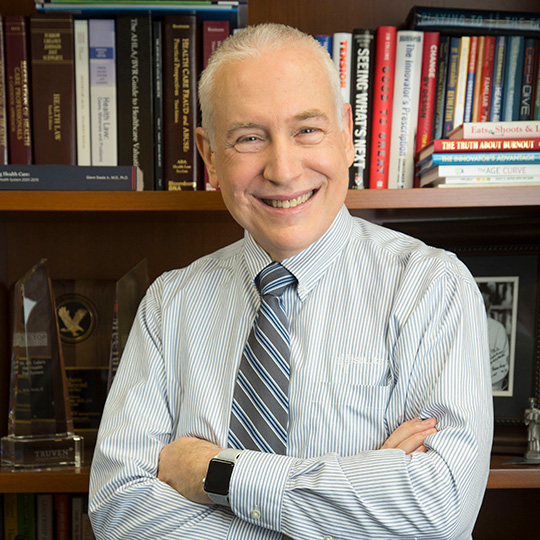Dr. Pate’s Prescription for Change
Advice for Jeff Bezos, Jamie Dimon and Warren Buffett from St. Luke’s President Dr. David Pate

Earlier this year, the leaders of Amazon, Berkshire Hathaway and JPMorgan Chase announced a collaboration to improve the experience and lower health care costs for their U.S. employees. There were no specifics, but they announced a search for a “top-notch CEO” to lead the venture.
There has been much interest in what this venture might do to transform health care and what the implications for health care might be. Here are my thoughts.
The CEO first needs to know what success looks like, and on what timeline. If the timeline is short, the opportunity might well be in savings from managing people with chronic illnesses more effectively. If the timeline is long, the opportunity is in prevention, which will save significant costs down the road.
Potential savings are to be found in the areas of prevention, the reduction of low-value/no-value services and chronic disease management.
Prevention
I would want to understand the employee base of these three companies and the average tenure of employees with the companies. If, on average, employees stay with the company 10 or more years, then investments in health behaviors can pay off for the companies, and that would be the period of time over which the CEO could be expected to demonstrate a return on investment for prevention programs.
Health care is too expensive in the U.S., and accounting for the majority of healthcare spending is chronic disease. So it makes sense that, for example, there are far more savings to be had from preventing a case of diabetes than from savings through better management of a case of diabetes.
It’s similar for other major chronic diseases, the majority of which can be prevented through maintaining a healthy weight and diet, regular exercise, the avoidance of smoking and not drinking alcohol or drinking in moderation. The Blue Cross Blue Shield (“BCBS”) Health Index examined the medical claims of more than 41 million commercially (i.e., less than 65-year-olds) insured members of BCBS companies and identified the top conditions that contribute to the reduction in Americans’ overall health. The top seven conditions were hypertension (high blood pressure), major depression, high cholesterol, coronary artery disease, type 2 diabetes, substance use disorder and alcohol use disorder, five of which can be avoided through these lifestyle choices.
The CEO should review claims history for the employees and determine whether these same seven conditions are the top conditions within these companies. If so, that would weigh strongly in favor of the potential value to be realized through prevention and wellness programs.
And because nearly 40 percent of U.S. adults are obese (BMI > 30), the CEO should offer employees an incentive to complete a health risk assessment so as to determine what percentage of employees are obese.
Assuming that the workforce for these three companies mirrors the general population in terms of the top health conditions and obesity rates, the CEO should then implement workplace health and wellness programs. She should identify employees who have chronic diseases already and those who are at risk and begin programs targeting achieving a healthy weight and diet (plant-based, whole foods), promoting exercise and smoking cessation, and offer incentives for improvements in measures of health (weight reduction, reduction of waist circumference, physical activity that can easily be measured by health fitness apps and wearables, and smoking cessation) along with on-site and digital health coaching, healthy cooking classes and health club/fitness center memberships or discounts.
Once the program was up and running, she should extend it to spouses and significant others who are beneficiaries under the health plan.
Over the following years, the CEO should measure the trend of employee health measures, absenteeism, productivity, the prevalence of chronic diseases and health plan costs to evaluate the benefit of the program. This will take years, and the leaders of each of these companies will have to view this effort as an investment in a healthy workforce, which should result in happier, more productive employees.
Costs
Over the shorter term, there are cost-savings opportunities in directly contracting with health systems instead of purchasing a commercial insurance product. In each community where employees work and live, the CEO should identify a health system that is progressive and willing to commit to a value-based arrangement along with certain programmatic components.
The health system must be willing to take accountability for the outcomes of care and the total cost of care. The health system also must be willing to commit to reducing low-value/no-value services and to work closely with the CEO, review health claims data and design new programs and services to address opportunities identified by the data.
The health systems with which the venture would contract must have a strong primary care network. The CEO would want to encourage each employee to have a primary care physician. The primary care network should offer extended-hours care and actively work to reduce the number of avoidable emergency room visits that could have been taken care of in physicians’ offices or urgent care clinics.
Based on the data, the CEO and the health systems would identify opportunities to reduce low-value/no-value services. In Idaho, for example, we know that there historically has been excess imaging for back pain and an excessive number of spine surgeries.
Then, the health systems must commit to work on reducing the low-value/no-value services, much the way St. Luke’s is working on back pain management and spine surgery to achieve better outcomes at a lower cost.
In every population, a small percentage of the population (roughly 5 percent) accounts for nearly half of all the healthcare spending. The CEO should use analytics to identify that 5 percent of employees and their beneficiaries, as well as those individuals with rising risk – those who have been significantly increasing their use of healthcare services.
She should identify these high-risk patients for the contracted health systems and then require the health systems to engage these patients in disease management, care coordination and transitions of care management programs. This would also be the group to be considered for remote monitoring to ensure that their disease conditions are being optimally managed in between doctor visits and hospital stays.
Finally, the CEO should explore opportunities with Amazon leadership to solve related challenges.
One problem would be the cost of medications. According to a study by the University of Southern California’s Neeraj Sood, 41 cents of every dollar spent at a retail pharmacy for medications goes to middlemen in the supply chain – wholesalers, pharmacies, pharmacy benefit managers and insurers. Given Amazon’s expertise in supply chain, and the fact that it has applied for pharmacy licenses in a dozen or more states, is there an opportunity for Amazon to decrease the prescription drug costs for this group of employees?
Another issue is medication noncompliance, which can lead to uncontrolled disease and an increase in hospitalizations. Can the IT and analytics teams of these companies design apps that would help drive improved medication compliance, perhaps using gamification?
The new CEO will have her job cut out for her. Taking on healthcare spending is intimidating; it is also exciting, and I see opportunity everywhere. Working with a long-tenured workforce creates the incentives to invest in prevention, and working with progressive health systems creates the opportunity for better primary care, disease management and care coordination. It will be exciting to watch from the sidelines while St. Luke’s continues its own journey to accomplish the same goals.
About The Author

David C. Pate, M.D., J.D., previously served as president and CEO of St. Luke's Health System, based in Boise, Idaho. Dr. Pate joined the System in 2009 and retired in 2020. He received his medical degree from Baylor College of Medicine in Houston and his law degree from the University of Houston Law Center.

